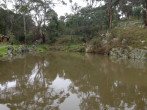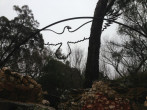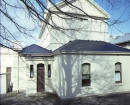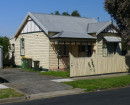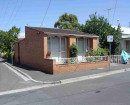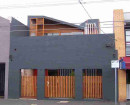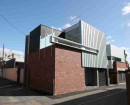SWIMMING POOL
SPRING CREEK THE POOLWAY HEPBURN SPRINGS, HEPBURN SHIRE
-
Add to tour
You must log in to do that.
-
Share
-
Shortlist place
You must log in to do that.
- Download report
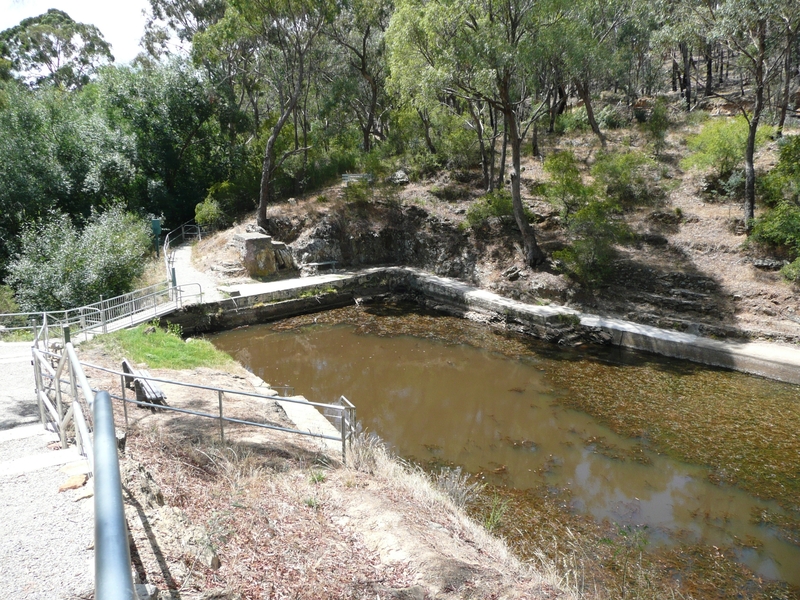

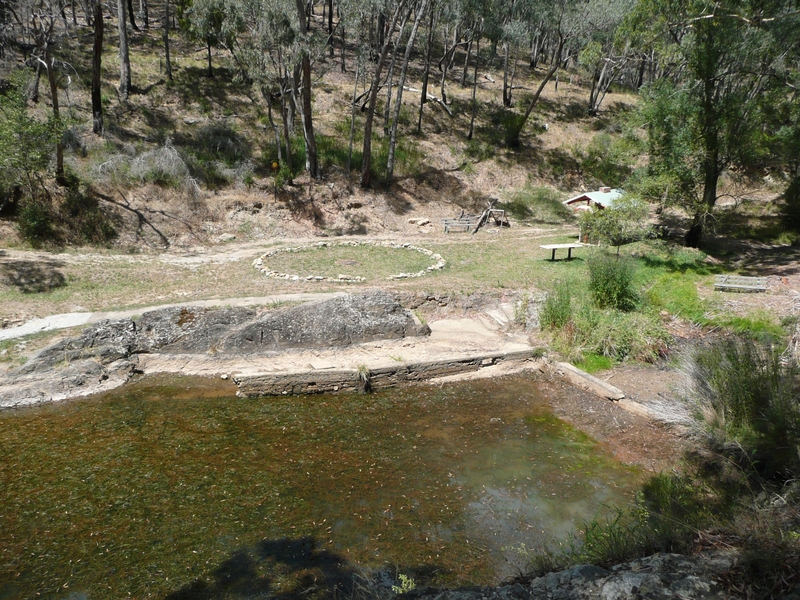
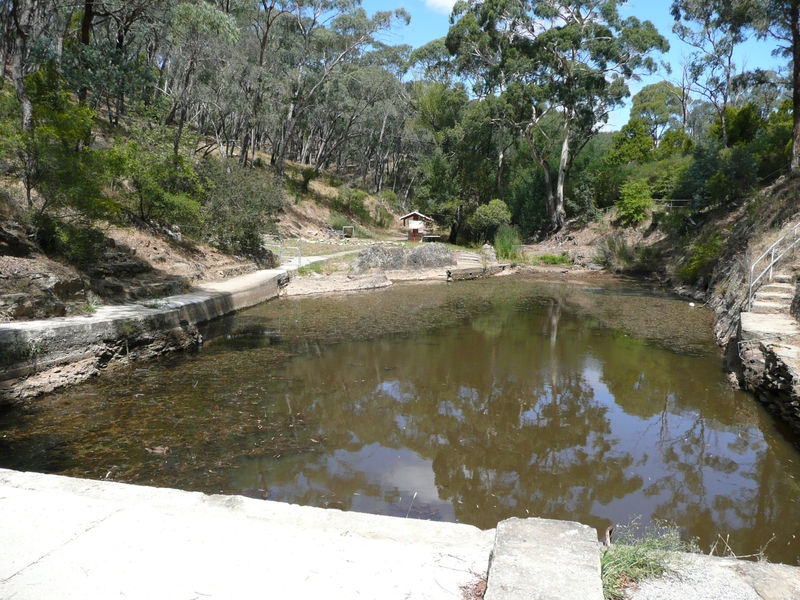
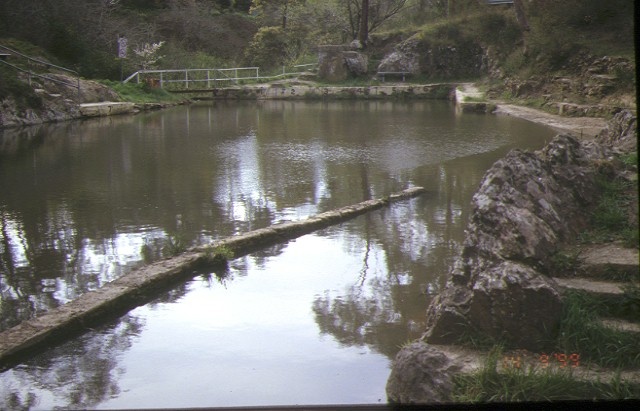
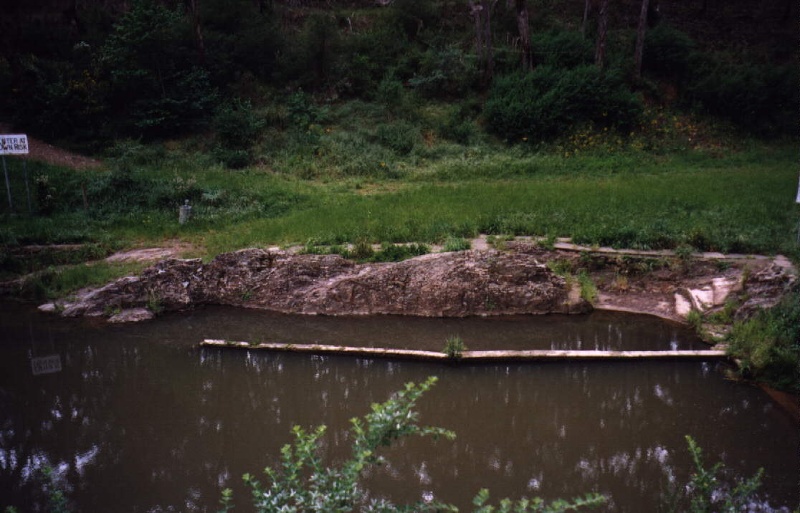
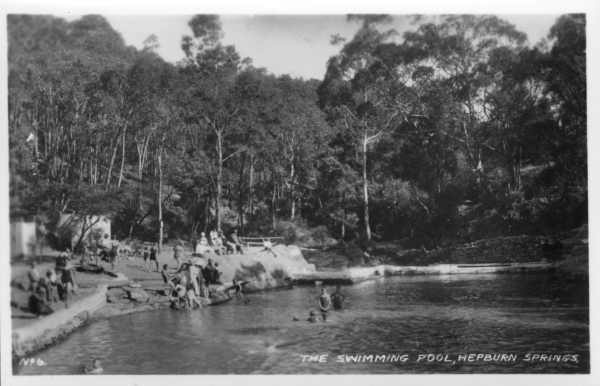
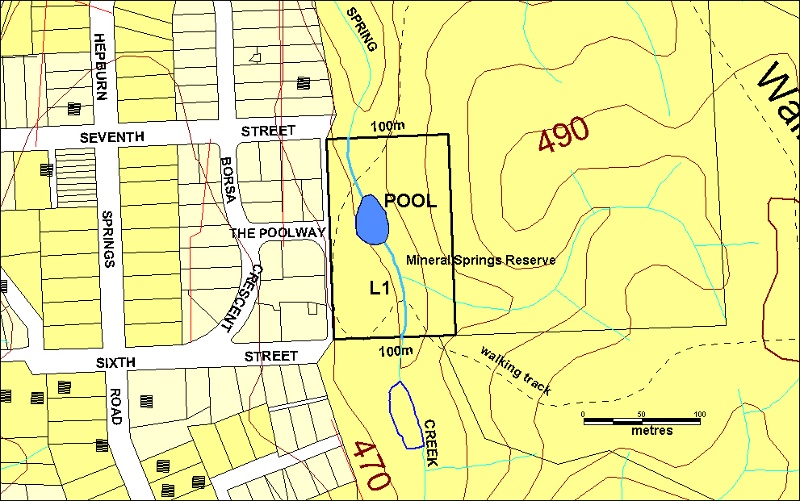
Statement of Significance
The Hepburn Springs Swimming Pool was built in the early 1930s by local labour and financed by Ernest and Victor Zelman, prominent Swiss Italian settlers. It consists of a concrete dam across a natural basin in Spring Creek with associated terracing. The basin was deepened by blasting. The dam has a small weir for flood water and a valve low down in the wall which handles normal environmental flow. The pool is within the Mineral Springs Reserve, which was created by early Swiss and Italian settlers and other interested citizens to protect the mineral springs from ruination due to mining. The pool is one of the early competition pools in the state, and was utilised for State swimming championships in the 1930’s. After a period of dilapidation the pool was refurbished by volunteers in 1993 using old photographs to replicate missing features such as seating.
The Hepburn Springs Swimming Pool is historically and socially significant to the State of Victoria.
The Hepburn Springs Swimming Pool is of historical and social importance as a rare, intact, surviving example of a community swimming facility created from a natural feature. Such pools were once commonplace in Victorian country towns but in most cases have either disappeared or fallen into disrepair. It is the best surviving example of its type and complements the Eastern Beach Swimming Complex (VHR929) in Geelong.
The Hepburn Springs Swimming Pool is a socially important link with an era of rising popularity of swimming, partly as a result of the fame of swimmers such as Annette Kellerman, and more importantly in Victoria, (Sir) Frank Beaurepaire who is known to have visited this pool on a number of occasions. Ironically, it was partly Beaurepaire’s championing of the Olympic pool standard that ultimately led to the demise of natural swimming pools.
The Hepburn Springs Swimming Pool is of historical and social significance for its long associations with the settlement of the State’s premier mineral springs recreational area based around Hepburn Springs. The construction of the pool was undertaken by descendants of the Swiss Italian immigrants who settled this area and it is located in an area directly associated with some of the prominent local guest houses, also owned at the time by members of the Swiss Italian community.
-
-
SWIMMING POOL - History
HEPBURN SPRINGS SWIMMING POOL
HERITAGE VICTORIA NOMINATION
COMPARATIVE ANALYSIS
(Information provided with the nomination by Lisa Gervasoni
Thematic History - Early Freshwater Swimming Pools in Victoria.
There are many reports of early swimming holes in 19th Century Victoria. Between the period 1895 - 1920, most rural Councils were under pressure to provide more formalised bathing arrangements. Often this occurred through the building of wooden enclosures in rivers, the damming of creeks, the construction of lakes, or the utilisation of old pits for the purpose.
Heat
In the main, most formalised early swimming areas were male only, or had a limited period were females could swim (closed to men). Many Council’s had bylaws prohibiting swimming in daylight hours. Many townspeople saw the need for a swimming area as a way to escape oppressive heat. Having to swim at night, the need for a safe swimming area and possibly the need for lighting were key concerns.
Women’s swimming
Whilst some clubs allowed women to swim during certain hours, it was not until the 1920’s when female swimming, and eventually mixed swimming became more accepted. It is interesting to note that the key woman behind the establishment a women’s swimming club at the Surrey Dive in Box Hill, Mrs Clarence Weber, later became the first female parliamentarian in Victoria.
Beaurepaire & Kellerman
The success of Frank Beaurepaire, the Olympic Swimmer, and his role with the Department of Education, had a large impact on the formalisation of swimming areas. Mr Beaurepaire would travel to swimming areas and give exhibitions. This raised enthusiasm and often led to the creation of improvements, and to swimming instruction and clubs, and encouraged other works.
Champion female swimmer Annette Kellerman, and her brother gave exhibitions. Kellerman created scandal in 1902 by introducing the one-piece bathing suit to America. Kellerman and her celebrity status in New York gave more acceptance to female swimming and championed in the new era of mixed swimming.
Tourism
As early as the 1920’s, and throughout the 1930’s the need to attract tourists was recognised by many Council’s. The presence of a swimming pool was seen as a key attractive factor. Victorian Railways often used photo’s of swimming pools to market destinations.
Examples of towns that built lakes and / or pools in this era, to attract tourists, include Beechworth, Healseville, Daylesford, Kilmore, Emerald and Hepburn Springs. These areas remain popular tourist destinations.
Lake Sambell in Beechworth was created in an area that was a large mine sluice to create an attractive feature for the town. A small, formalised concrete pool was later added (c 1950’s). Lake Daylesford was built over market gardens during the Depression, and a lake edge swimming pool was planned and constructed. Healseville created a large lake as a feature for a caravan centre (Yumbunga), Emerald Country Club utilised a large water feature and Kilmore gave a new lease of life to the old water reservoir. The pool at Hepburn Springs was built by a Guest House owner Ernest Zelman of Bellinzona, but was intended for both guest and public use.
Depression
Swimming was a popular and cheap pastime during the Depression. Some pools were created by sustenance gangs (Wandong), or improvements were made to existing facilities. The pool at Hepburn Springs utilised the available work force to build the weir wall, excavate the valley in places, and landscape the area with stone from the area.
Olympic Games - Melbourne - the end of the era.
Most of these "natural" swimming pools remained in use into the 1960’s. After the 1956 Melbourne Olympic Games, many swimming clubs lobbied Council’s to create ‘Olympic’ Swimming Pools, that were clean, neat and modern. The charm of the natural setting was of another era.
This desire to ‘modernise’ was soon assisted by a grant programme of the 1960’s that saw many of these original pools replaced by concrete pools. The old swimming pools were left unmaintained, and the great majority have now been demolished due to safety concerns about their dilapidated state.
References
Gregory EB, Gregory ML, Koenig WL, Coast to Coast; Winchelsea A History of the Shire, Shire of Winchelsea in conjunction with Hargreen Publish Company, 1985, North Melbourne
Bossence WM, Numurkah, The Hawthorn Press, Melbourne 1979.
Griffiths, T., Beechworth; an Australian country town and its past, Greenhouse Publications, 1987
Lemon, Andrew, Box Hill, Box Hill City Council in conjunction with Lothian Publishing Co Pty Ltd, 1978.
Martindale HG extended by Brennan N, New Crossing Place; A History of Seymour and its Shire, Shire of Seymour, 1982,
Hibbins, G. A History of the Nathalia Shire; the good helmsmen, The Hawthorn Press, Melbourne, 1978.
Symonds, S., Healesville; History in the Hills, Pioneer Design Studio, 1982.
Eunson, W, The Unfolding Hills; Mirboo Pioneers of the Gippsland Forests 1879 - 1914 with the acknowledgment of the contributions of Walter James Tuck MBE, Mirboo Shire Council, 1978.
Garden, D., Hamilton; A Western District History, City of Hamilton in conjunction with Hargreen Publishing Company, 1984.
Adam's, J So Tall the Trees; A history of the southern districts of the Narracan Shire, Narracan Shire Council, 1978.
Brooke, B & Finch, A., A Story of Horsham; A Municipal Century, City of Horsham 1982
Adams, J From these beginnings; History of the Shire of Alberton Alberton Shire Council, 1990.
Murphy, J., No Parallel; the Woorayl Shire 1888 - 1988, Shire of Woorayl in conjunction with Hargreen Publishing Company.
Adams J., Path Among the Years; History of Shire of Bairnsdale, Bairnsdale Shire Council 1987.
Bossence, WH., Kyabram, The Hawthorn Press, Melbourne, 1963.
Bate, W., A History of Brighton ; 2nd edition, Melbourne University Press, 1983.
Maher, JA., A Tale of a Century - Kilmore; 1837 - 1937, Lowden Kilmore 1938, reprint 1972
Tucker, MV., Kilmore on the Sydney Road., Shire of Kilmore, 1988.
BACKGROUND TO TYPE AND NUMBER OF POOLS
Table 1 shows the number of pools present in Victoria before the modern Olympic period. While this is not exhaustive, it is a fairly indicative of the number of pools present. The figures have been collated by reference to the State Library of Victoria Multimedia collection, published local histories where available, memory of former lifeguards and by examination of the VicRoads Country directory for possible locations.
Phone enquiries to Council’s and to local communities have been utilised to discern what has happened to these pools. Pools that are still in existence form Table 2.
Number of pools - pre modern Olympic period - 56
Number of pools pre modern Olympic period in existence with pool structure remaining 5 - 6
Whilst these figures are not exhaustive, they show the rarity of remaining pools with structural integrity in Victoria. These pools remind of us of another age, and of Australian ingenuity. While modern swimming regulations may make it difficult for Council’s to allow for their use as functional swimming pools, the remaining places should be documented and preserved.
They were once seen as tourist attractions, they offered a additional benefit over a town without a pool. Today this purpose remains. In their preservation and interpretation, they provide an educative tourist attraction. They are places where the former champion swimmers that introduced freestyle, and kick turns, learnt to swim and taught others. It is in these places were champion swimmer and movie star Annette Kellerman, whose story was immortalised in the ‘water dance’ 1952 feature "Million Dollar Mermaid" swam. Kellerman is also attributed as being the creator of the modern synchronised swimming.
Swimming is still a sporting activity at which Australians excel. Links with the development of the swimming as a sport should be recognised. It is fitting that in the year leading up to the second Olympic Games in Australia that the development of swimming is recognised. Those pools that survived the ‘profesionalisation’ endangered by the first Olympics are well placed to be the physical means by which to interpret that history to future generations.
BACKGROUND TO TYPE OF EARLY SWIMMING POOLS
River
River pools were usually created by the placement of stone or wooden swimming enclosures in the stream adjacent to the banks. They were often located at deep pools, or upstream of weirs. These were sometimes lit, and often had quite formal tiered seating. Pavilions and pontooning were also popular to provide changing and viewing areas. Most of these pools had long diving boards extending out over the river, and several had diving towers of between 3 to 10 metres.
Of the plethora of semi formalised swimming areas created on river banks, only the Werribee enclosure seems to remain as an example of the era.
Creek
Creek swimming pools were often similar to that of the river class, excepting the need for wiering of some sought to ensure water permanency and depth. Often these pools were created upstream of existing weirs such as Euroa and Bright. At both these sights all evidence of former pools have been erased, with the exception of more recent concrete edging at Euroa.
Other weirs were purposely built to provide for swimming. The weir structures were usually less formal, and not as well constructed. For example the pool at Mardan utilised a dam wall structure reinforced with timber. The valve function was performed by the construction of a timber lined sluice which was blocked by earth bags. These were removed to '‘flush’ the pool. Due to flood damage this structure was changed to one lined with reinforced concrete. This pool has not been demolished, but is abandoned and privately owned with no access to the public.
The construction of a concrete weir wall, and the excavation of a swimming area created the Hepburn Pool. The natural incline and rock surface was utilised on one side as access, and for caved bench seating, and towel areas. On the other side, concrete edging and benching was interspaced with large rocks to create natural looking seating. The weir wall incorporates a low valve, that keeps stream flow, and ensures a constant change and cleansing of water. It is believed to be the only such valve utilised in this type of pool construction. Natural stone was used for diving blocks, and is still present. Infrastructure is fairly intact, including rails to enter / exist the pool.
No other pool still in existence from the era has maintained both the structural integrity of the area, and a majority of the features that make it instantly recognisable as a pool.
Another form or creek pool is the Buchan Pool. It is an early concrete pool that is fed by an underground stream. This pool is still in existence, but is more akin to the early concrete pools that natural swimming pools.
The pool at Vaughan Springs is a natural pool that has been created by a weir. No formal swimming infrastructure existed.
Lake
Lake pools consisted of two main categories; natural and man made lakes. Generally the infrastructure provided was the same, with the exception of smaller pools, such as Lake Daylesford, that built a swimming enclosure on the edge of a lake – like the river enclosures.
Lakes often had a pontoon in the middle, for diving. This would sometimes house a diving platform. Springboards, and 3 - 10 metre towers were common. Formal pavilions and large pontoons over the water were utilised.
Lake Pools are arguably the worst affected by recent demolitions of swimming infrastructure. There are no excellent examples left of this category. Bendigo - Upper Reserve, Cato Park Stawell and the Emerald Country Club were fine examples of the grandeur these structures could reach.
Some semblance of the former pool at Yarrawonga is present, but, as this is an example of a swimming box, it was never as formalised and grand as many other examples. The pool at Heany Park is still in existence. The diving platform has collapsed. The area is now managed by the Scouts, who wish to restore the pool in the future.
Of the lake category of pool, those at Blackwood and the Cascades in Emerald were most reminiscent of the setting that the Hepburn Pool has created. They are both natural lakes in steep valleys that once had swimming infrastructure.
Quarries / Reservoirs
Quarry and reservoir pools were rarer, they most closely resemble the grandeur of the lake pools, and represent a clever utilisation of surplus infrastructure. The Kilmore Pool and Yumbunga were examples of this genre. The lake structures are still present, but swimming infrastructure has been removed.
The most famous of this genre of pool was the Surrey Dive in Box Hill. It was over 100m long and up to 80 feet deep, and the woman who fought the fight to establish women’s bathing (Mrs Clarence Weber) went on to become the first female parliamentarian in Victoria. This pool was nearly emptied during the late ‘60’s drought, and has now been filled in, and a shallow lake covers part of the site.
The other example of a quarry pool is St. Arnaud. This pool was concrete lined, and featured many large diving structures, pavilions and sheds. Although fenced off, evidence of the pool and its structures are present.
ASSESSMENT OF THE HERITAGE VALUE OF EARLY SWIMMING POOLS
Rarity
% pools left - total and by category
Type No. Pre Olympic Period No. Existing Now original % remaining
River 21 1 4.8
Creek 7 1 14.3
Lake 14 1 7.1
Quarry/ 5 2 40
Reservoir
It should be noted that all remnant pools are now rare. River structures are now rare due to the rate of their demolition, where other classes of pools were already relatively rare in comparison.
Technology and ingenuity
The construction of a concrete weir wall and the excavation of a swimming area created the Hepburn Pool. The natural incline and rock surface was utilised on one side as access, and for caved bench seating, and towel areas. On the other side, concrete edging and benching was interspaced with large rocks to create natural looking seating. The weir wall incorporates a low valve, that keeps stream flow, and ensures a constant change and cleansing. It is believed to be the only such valve utilised in this type of pool construction. Natural stone was used for diving blocks, and is still present.
No other pool still in existence from the era has maintained both the structural integrity of the area, and a majority of the features that make it instantly recognisable as a pool.
The St. Arnaud Pool represents the ability to make best advantage of what you have. The ‘give it a go’ quality. The ingenuity of the small and remote town to create a large and fully lined facility that hosted many major carnivals should be appreciated. Systems must have been in place to provide clean water, showing practical application of technology for recreational purposes.
Buchan is another example of innovation. Karst topography was utilised to fill and flush an early concrete pool. Being concrete, the pool has survived eras of safety audits, and has been upgradeable without serious impact on its integrity. The stream fed mechanism remains.
Interpretation and representative value
The Werribee River Pool, the Hepburn Pool and the St Arnaud Pool are the three main intact examples of the main three classes of pre modern Olympic swimming pools. Buchan is representative of early concrete pools. Few examples remain, and its use of underground water gives it interpretive value.
Consideration should be given to Registering these places due to their ability to teach people about a different era in swimming, and of Australian ingenuity.SWIMMING POOL - Assessment Against Criteria
Criteria A The historical importance, association with or relationship to Victoria's history of the place or object
The Hepburn Pool is part of the Mineral Springs Reserve, which was created by early Swiss and Italian settlers and other interested citizens, to the area to protect the mineral springs from ruination due to mining. This Swiss Italian nature of the Hepburn Springs area is unique in Victoria, as in the late 1850's 10% of the population spoke Italian. This heritage is celebrated by the local community each year in the Swiss Italian Festa, and is recognised by the many Heritage Victoria listed Swiss Italian buildings in the immediate vicinity, and outlying areas.
The pool was built by Ernest and Victor Zelman, prominant Swiss Italian settlers, one of whom married the daughter of Battista Borsa, the original owner of 'Bellinzona'Guest House in the early 1930's. The pools' location shows its direct linkage to the Bellinzona site, as Borsa and Fabrizio Crippa (Parma House) originally owned the land running down to the pool.
The pool is the result of a man made dam at the base of a natural basin in Spring Creek, overseen by the Milesi's , who used an innovative valve low in the dam wall to allow fresh water to flow through Spring Creek. It also kept the water clean for swimming, and is an early example of creating environmental stream flow.
The pool is one of the early competition pools in the state, and was utilised for state swimming championships in the 1930's.
It is believed to be home of the first practioners of the 'kick turn', as taught by a local Swiss Italian descendant, and member of the swimming club to the state swimmers of the era. They were amazed by his ability to beat them at training, and he taught them the turn technique used at the pool. This technique would prove to revolutionalise swimming.
Criteria B The importance of a place or object in demonstrating rarity or uniqueness
The Hepburn Pool is one of three pools of its type in Victoria - see attached citation by National Trust of Australia (Victoria). Of these pools, it is believed to be the only pool that was home to state championships.
The pool is in very good condition due to the dedication of local residents in protecting and restoring the pool, after it had been allowed to silt up and become overgrown with willows. The restoration was completed in 1994, and the local community have been proud caretakers and defenders ever since.
The pool was built by Ernest and Alberto Zelman, members of a very important family in Victoria's artistic and musical development. The Zelman's played an important role in its continual upkeep, and aesthetic environs, including tree planting. The dedication of the local community to restore it, and plant new trees, which they water by hand, is homage to keeping the tradition and importance of the sites culture, established by the Zelman's, Crippa's, Milesi's, Perini's, Tinetti's, Pedretti's, Gervasoni's and others alive through the generations.
The deep end was blasted from rock to add extra depth. The remaining rock face has been utilied for seating, and tiered steps to the pool.
The pool was an early location of 'learn to swim classes.' Many Melbourne children learnt to swim at the Hepburn Pool, and received a Herald certificate. Swimming classes were taught by the local caretaker of the pool, Mr Ridgely, who was quite a local identity. Not being able to swim himself, he invented a harness system attached to a pole, that allowed children to be supported whilst swimming. During quite periods he would water and maintain the gardens to complete the picturesque setting.
Criteria C The place or objects potential to educate, illustrate or provide further scientific investigation in relation to Victoria's cultural heritage
The site is a critical link in Victoria's cultural heritage. The area of Hepburn Springs is already recognised by Heritage Victoria due to its values - especially in regard to the Swiss and Italian settlers of the area, and the mineral springs. This site is within the mineral springs reserve, and the structure was built by Zelman - hence its links to Bellinzona Guest House, and other guest houses in the area. The pool reflected the community spirit of the area, as it was available to all Hepburn Springs community members, as well as guests of all surrounding tourist facilities, boasted a swimming club, and held swimming competitions at state level.
The site was, and still is, important to the people of the area, and shows their ingenuity and ability to work with nature and stone, and to use the enviornment without destruction or degradation of its values. This is a trait that shows the knowledge of the early Swiss stone masons of the area. This philosophy remains true in their descendants.
The pool shows how it is possible to construct a swimming pool with a natural appearance, that has little impact on the natural water flow. The ingenious system of a lower value allowing water from the bottom of the pool to escape, as well as a spill wall, allows for clean water in the pool at all times - people who cannot swim in a pool full of chemicals can swim at Hepburn, and wildlife, such as platypii still swim there, much to the delight of local residents.
This illustrates the importance of water to the culture of the early settlers and their desire to ensure the multi use of the resource without its degradation. The Pool represents an excellent example of this, and of the perilous position of nature. When functioning, it is a recreational facility, a tranquil landscape, a natural habitat, a critical source of water for fire fighting purposes, a place of relaxation and healing that maintains environmental stream flow.
The degradation of the pool, and filling with silt due to the piggery, and then poor land management practices during land development in Daylesford provides a perfect interpretation of the fine balance of natural systems. The communities dedication to its restoration and to the prevention of further degradation is also an excellent example of simple actions to preserve our cultural heritage.
The pool was also the training ground of our early competitive swimmers, and where they learnt and practiced the kick turn, which in conjunction with the Australian Crawl, revolutionised competitive swimming in the 1930's. The 'primative' nature of the pool perfectly illustrates developments within swimming, and the ruggedness of our early swimmers.
Criteria D The importance of a place or object in exhibiting the principal characteristics or the representative nature of a place or object as part of a class or type of places or objects
The pool is one of the few 'natural' pools of a length and depth suited to competitive swimming before the proliferation of inground pools. It achieves this, in the majority, by using natural contours. It is fair to say that it is the only example of a pool with these principle characteristics, and only one of 3 in this class of pool.
The pool has been well patronised and loved by locals and guests to the region alike, as is illustrated in the article attached.
The natural beauty of the area is clearly illustrated in the photo's, However, no photo can truly capture the atmosphere of the area when viewed in person. Very few cultural landscapes are recognised by Heritage Victoria, nore 20th century community facilities. The Hepburn Pool is the perfect example of a cultural landscape which builds on, and interprets the values of the previous generations to form a homogenous and timeless blend between era's of development.
Criteria E The importance of the place or object in exhibiting good design or aesthetic characteristics and/or in exhibiting a richness, diversity or unusual integration of features.
The pool, strictly in the design sense, is rare. It works with the natural contours and materials of the site - to seemingly arise naturally from its surrounds. The diving blocks are carved from a stone outcrop to complete the creative use of nature, and to truly integrate the pool into the natural beauty of the area. The stairs and viewing platforms also utilise the natural landform creatively. This again shows both the artistic and stone masonry skills of the local population, to create such a perfectly funtioning pool, without detracting from the environment of the area, and downstream habitat.
Each generation has added its own feature to the area, without impacting on the integrity of the structure and its setting. During the second world war (1942) the Public Works Department oversaw the construction of the weir to both guarantee water levels in drought, and to reduce and sedimentation from development upstream. This saw the pool maintained in excellent condition until the 1960's.
The approval of the piggery saw the battle lost until, 3 generations, those who were children at contruction, their children and grand children banded together to restore the pool to its former glory. Utilising the same manual labour and watering by bucket techniques of their ancestors the pool was returned to its previous state. To mark its resurrection a plaque and frescoe were added at the diving blocks.
The frescoe envokes connections to the Italian art style, which was in use in the area - as evidenced by the frescoes in Parma House and the Macaroni Factory. The wording of the plaque shows the unifying force of the structure - it is where all areas of the community area as one - whether Swiss, Italian, Irish, Engligh, German, Jewish or indigenous Australian. The words are inspired by Koori culture, but accurately reflect the communities feelings on the area:
'The shining water that moves in the streams and rivers is not just water but the blood of our ancestors.'
Criteria F The importance of the place or object in demonstrating or being associated with scientific or technical innovation or achievements
The site is an example of the skill and craftmenship of the 1920's. The ability to create such a place with today's technology is questionable. In fact, if the valve structure is 'removed' it would not be able to be replaced, and the beauty and cultural value of the pool would be lost forever. The first article in attachment F, clearly shows the loss of landscape value without the pool.
The seeming naturalness of the pool, shows the technical skill of the designers and builders. Natural topography was used for the main pool area, and natural ourcrops of stone for the seating, terracing and diving areas.
The building and upkeep required great community support, in a time of great hardship: the Great Depression. The tradition of creating and protecting community resources, like our forefathers is a willing legacy that has been taken up by todays' community.
The site is where new innovations in swimming were practised during the depression, when the harshness of the economic situation required creative and inexpensive solutions. The Hepburn Pool, being free to the community, and of a high standard, allowed swimmers to train without great expense and practice the new styles and techniques.
Criteria G The importance of the place or object in demonstrating social or cultural associations.
The place shows the continued association of locals to the springs reserve, each generation adding a new feature to the area. When the pool fell into disrepair, the community banded together and spent two years restoring the site, and establishing a picnic area so that future generations could enjoy its beauty and tranquility. It is rare to have a community so united over an issue, and prepared to labour, for a year to restore a cultural icon to its former glory
The site has many important social associations. It is linked to the Springs Reserves, as well as a direct linkage to the creators of each state listed heritage site in Hepburn Springs. It is one of the many sites where the Swiss Italian Community created for their recreation and social interactions as well as to attract visitors to guest houses.
Of all the sites in the community, is has the greatest importance, as it was were all families and guests came together - it was special to all. It is truly a unifiying factor within the permanent community, and between the 'locals' and visitors.
After the war, the Hepburn area became very popular with the Jewish community, as Jewish settlers spendt their summer holidays in the area. The Jewish people had survived the trauma of concentration camps, and valued the peace and tranquility of Hepburn Springs, and its ability to provide a range of activities from walking, mineral springs and the pool. In many ways, the whole Springs Reserve, including the pool, was a healing place, the spa complex for physical healing, and the traquility of the pool for emotional healing.
Unlike the commercial or residential buildings recognised for their cultural value in the area, the pool shows the dedication to creating facilities for the whole community. The citations for these listed dwellings mention the culture and the lifestyle of the occupants, the balls and sporting competitions they frequented. The pool is probably the most important evidence of this culture and community spirit remaining today. Many local residents, such as Laurie Sullivan, Marie Butler (Perini), Tom Gervasoni and Bernie Milesi have the first hand knowledge of its construction, use, neglect and rebirth, and have instilled in each ensuing generation the oral history required to ensure each generation values and understands its past.
The close nexus between the Springs Reserve, Bellinzona, Parma House, the Macaroni Factory, and the pioneers of the district has been shown previously. The Springs Reserve was created by Perini, who was a key figure in the creation and early management of the Pool. The pool itself was developed by the owners of Bellinzona and Parma House, and was utilised by all in the community. Like the macaroni factory, the creation of a pool was another element in creating the conditions similar to the spa areas of northern Italy.
Criteria H Any other matter which the heritage council considers relevant to the determination of cultural heritage significance
? almost 100% support for protection by the local community
? important fire fighting water source - Hepburn Springs burnt to ground in 1906 - and a permanent water supply was considered necessary. The pool still performs this function. Many propertiess were destroyed by the 1906 fire, which in turn created the Edwardian Elegance of the town today. If fire was to endanger the town again, as is likely due to its location in a cleared valley, surrounded by forest, Heritage Victoria classified buildings would be endangered, The pool is the only water supply available for fighting purposed in the area, and has easy access to the CFA, with no danger of loss of pumping power, or need to travel through bush to reach the water.
? Where John Marshall - diving champion of Victoria trained and competed
? The deep end required blasting, and the pool was manually constructed, and concrete was mixed on the spot. Bellinzona would bring down buckets of tea for the workers.SWIMMING POOL - Permit Exemptions
General Exemptions:General exemptions apply to all places and objects included in the Victorian Heritage Register (VHR). General exemptions have been designed to allow everyday activities, maintenance and changes to your property, which don’t harm its cultural heritage significance, to proceed without the need to obtain approvals under the Heritage Act 2017.Places of worship: In some circumstances, you can alter a place of worship to accommodate religious practices without a permit, but you must notify the Executive Director of Heritage Victoria before you start the works or activities at least 20 business days before the works or activities are to commence.Subdivision/consolidation: Permit exemptions exist for some subdivisions and consolidations. If the subdivision or consolidation is in accordance with a planning permit granted under Part 4 of the Planning and Environment Act 1987 and the application for the planning permit was referred to the Executive Director of Heritage Victoria as a determining referral authority, a permit is not required.Specific exemptions may also apply to your registered place or object. If applicable, these are listed below. Specific exemptions are tailored to the conservation and management needs of an individual registered place or object and set out works and activities that are exempt from the requirements of a permit. Specific exemptions prevail if they conflict with general exemptions. Find out more about heritage permit exemptions here.Specific Exemptions:General Conditions:
1. All exempted alterations are to be planned and carried out in a manner which prevents damage to the fabric of the registered place or object.
2. Should it become apparent during further inspection or the carrying out of alterations that original or previously hidden or inaccessible details of the place or object are revealed which relate to the significance of the place or object, then the exemption covering such alteration shall cease and the Executive Director shall be notified as soon as possible.
3. If there is a conservation policy and plan approved by the Executive Director, all works shall be in accordance with it.
4. Nothing in this declaration prevents the Executive Director from amending or rescinding all or any of the permit exemptions.
5. Nothing in this declaration exempts owners or their agents from the responsibility to seek relevant planning or building permits from the responsible authority where applicable.
* The maintenance of trees, rock walls, foundations, terracing, the dredging of the pool, the maintenance of the bridge and the maintenance of all contemporary picnic, seating and safety facilities is permit exempt provided that maintenance to the original features continues in the same material and detail as existing.SWIMMING POOL - Permit Exemption Policy
The pool is mainly important as a rare, intact surviving type of community facility created out of the natural landscape features. The interim policy for this heritage place is that maintenance work which continues the upkeep of the man made features is permit exempt. A major overhaul of the site or any new building works will be subject to a permit.
-
-
-
-
-
FORMER MACARONI FACTORY
 Victorian Heritage Register H0407
Victorian Heritage Register H0407 -
PARMA HOUSE
 Victorian Heritage Register H0608
Victorian Heritage Register H0608 -
HEPBURN MINERAL SPRINGS RESERVE
 Victorian Heritage Register H2098
Victorian Heritage Register H2098
-
1) ST. ANDREWS HOTEL AND 2) CANARY ISLAND PALM TREE
 Nillumbik Shire
Nillumbik Shire
-







